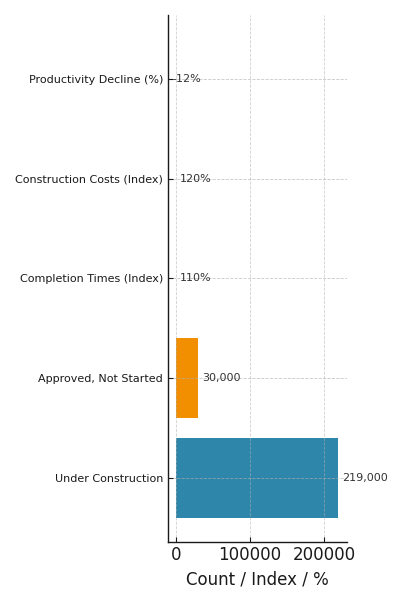More Approvals, More Problems? Why Australia’s Housing Pipeline Is Stuck — and How to Protect Your Build
- Eli Maguire
- Aug 14
- 3 min read

Approvals are flowing, but construction capacity is running dry. Australia’s housing targets are ambitious, but without solving the build-phase bottleneck, the gap between approvals and completions will only grow. For homeowners and investors, that means greater risk — unless you have the right builder and systems in place.
The Ambitious Goal That’s Hitting Reality
In August 2023, the National Cabinet announced a plan to build 1.2 million new homes in five years. While the intention is admirable, the reality is less promising. Government can influence planning and approvals, but the real challenge lies in delivery — and the current system is already stretched to breaking point.
According to the ABS, there are over 219,000 homes currently under construction, with completion times blowing out and builders struggling to keep projects on track. Without addressing productivity and capacity, more approvals will only add to the congestion.

Lessons From 2019
The last time Australia got close to that 1.2 million completion mark was in the five years to the end of 2019. But market conditions then were far more favourable:
Cash rate averaged 1.6% (compared to around 4.18% today)
Units accounted for 46% of approvals, making projects easier to scale
Higher investor and foreign buyer activity drove presales for larger developments
Even then, high completion numbers didn’t guarantee better housing outcomes. Home ownership rates actually fell, some investor returns were poor, and building defects were rife. The takeaway? More dwellings don’t always mean better results.
Why Approvals Aren’t Climbing
State governments have introduced upzoning, pre-approved design patterns, and developer incentives. NSW, Victoria, and Queensland have all taken steps to make planning faster and more flexible.
Despite this, approvals remain below the level needed to hit government targets. Reasons include:
High interest rates affecting demand and developer confidence
Affordability constraints and cost-of-living pressures
Lingering buyer caution after the 2021–2023 surge in construction costs
The Pipeline Bottleneck
Even if approvals rise, the industry’s current backlog poses a bigger problem:
219,000 dwellings under construction
30,000 dwellings approved but not started
Productivity in dwelling construction down 12% since the mid-1990s
Without better productivity and capacity, more projects in the pipeline will simply mean more homes delayed.
What This Means for Homeowners and Investors
When the system is this congested, risks increase:
Delays stretching timelines by months
Cost blowouts from material and labour shortages
Quality issues from overworked trades
For anyone building in 2025, the real challenge isn’t getting approved — it’s ensuring the home is completed on time, on budget, and to the right standard.

How EDM Building Protects Your Project
At EDM Building, we’ve built systems to shield clients from these risks and deliver with certainty, even in a congested market.
1. Comprehensive Pre-Construction PlanningOur Design to Delivery and Dreams to Reality packages include feasibility reviews, detailed construction costing, and realistic timelines before work begins.
2. Trusted Trade NetworkWe work with subcontractors we know and trust, ensuring consistent quality and accountability.
3. Stage-by-Stage Quality ControlOur EDM Quality Control Checklist means no stage progresses until the work meets our standards.
4. Transparent CommunicationWeekly updates, milestone reports, and open-book budgeting keep you fully informed.
5. Contingency PlanningWe build in buffers to absorb unexpected market shocks without derailing your project.
The Bottom Line
More approvals don’t solve the housing crisis if the homes aren’t delivered. The real win for homeowners and investors is working with a builder who can navigate today’s challenges and see your project through from start to finish.












